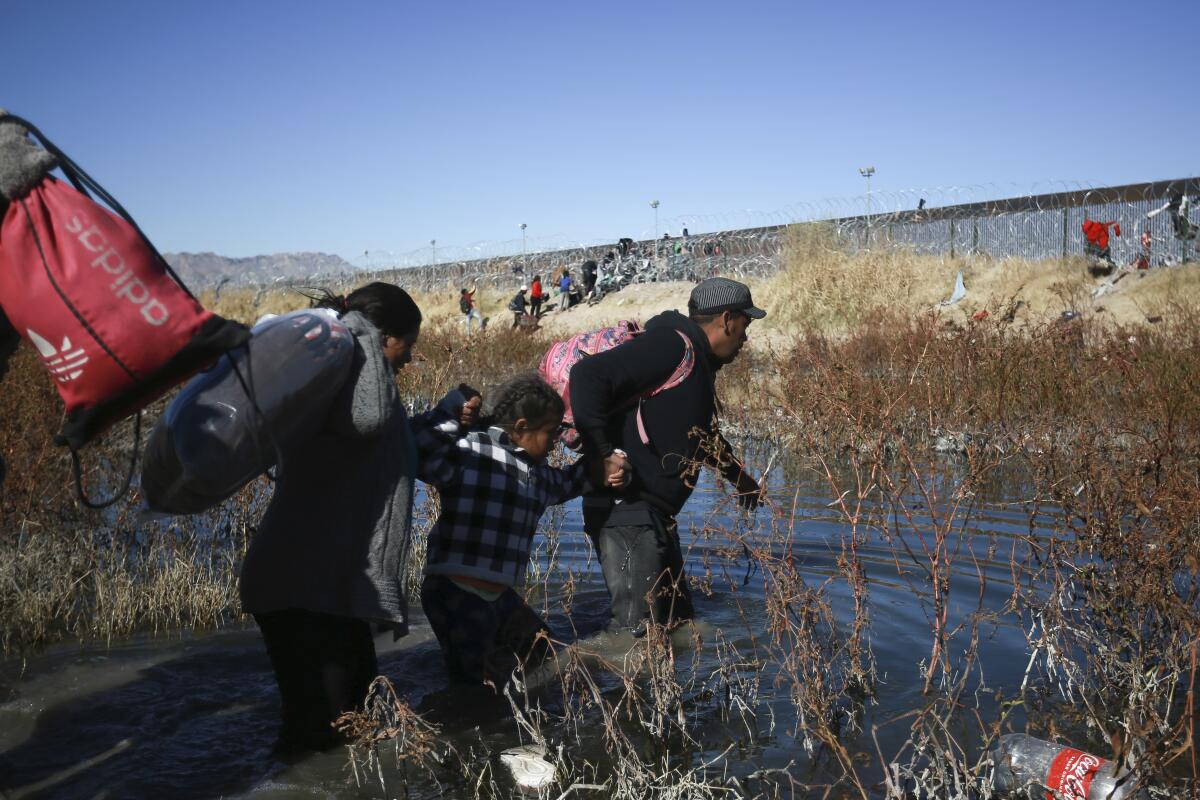Mexican officials clear border camp as U.S. pressure mounts to limit migrant crossings

- Share via
MATAMOROS, Mexico — A ragged migrant tent camp next to the Rio Grande is a long way from Mexico’s National Palace, where a U.S. delegation met this week with Mexico’s president seeking more action to curb a surge of migrants reaching the U.S. border.
But as Mexican officials in Matamoros dispatched heavy machinery to clear out what they said were abandoned tents at the camp, the action was a likely sign of things to come.
The United States has given clear signs, including temporarily closing key border rail crossings into Texas, that it wants Mexico to do more to stop migrants hopping freight cars, buses and trucks to the border.
President Andrés Manuel López Obrador said he got a worried phone call on Dec. 20 from President Biden.
“He asked, Joe Biden asked to speak with me. He was worried about the situation on the border because of the unprecedented number of migrants arriving at the border,” López Obrador said Thursday. “He called me, saying we had to look for a solution together.”
Mexico, desperate to get the border crossings reopened to its manufactured goods, started to give indications it would crack down a bit. López Obrador said Thursday that Mexico detained more migrants in the week leading up to Christmas than the United States did, with Mexican detentions rising from about 8,000 a day on Dec. 16 to about 9,500 on Dec. 25.
That increased effort appeared to be on display in Matamoros as U.S. Secretary of State Antony J. Blinken held talks with López Obrador in Mexico City.
Migrants set up the encampment across from Brownsville, Texas, in late 2022. It once held as many as 1,500 people, but many tents were vacated in recent months as people waded across the river to reach the United States.
“What we are doing is removing any tents that we see are empty,” Segismundo Doguín, the head of the local office of Mexico’s immigration agency, said.
But one Honduran who would give only his first name, José, said some of the 200 remaining migrants were practically forced to leave the camp when the clearance operation began late Tuesday.
“They ran us out,” he said, explaining that campers were given short notice to move their tents and belongings and felt intimidated by the bulldozers. “You had to run for your life to avoid an accident.”
Some migrants moved into a fenced-in area of the encampment where immigration officers said they could relocate, but fear remained.
About 70 migrants flung themselves into the river Tuesday night and crossed into the U.S. They were trapped for hours along the riverbank beneath the layers of concertina wire set up on order of the Texas governor.
Few options exist for the migrants who were asked to leave the encampment, said Glady Cañas, founder of a Matamoros-based nongovernmental group, Ayudandoles a Triunfar, or Helping Them Win.
“The truth is that the shelters are saturated,” Cañas said.
She was working at the encampment Wednesday afternoon, encouraging migrants to avoid crossing illegally into the U.S., especially after several drowned in the last few days while attempting to swim the river.
This month, as many as 10,000 migrants were arrested daily on the southwest U.S. border. The U.S. has struggled to process them at the border and house them once they reach northern cities.
Mexican industries were stung last week when the U.S. briefly closed two vital Texas railway crossings, contending that border patrol agents had to be reassigned to deal with a large number of migrants. A non-rail crossing remained closed at Lukeville, Ariz., and border operations were partially suspended at San Diego and Nogales, Ariz.
Speaking Thursday, López Obrador said the meeting with U.S. officials focused on reopening border crossings.
“We have to be careful not to close the crossings, we reached that agreement, the rail crossings are being reopened, and the border bridges are returning to normal,” he said of the meeting with Blinken, Homeland Security Secretary Alejandro N. Mayorkas and Homeland Security Advisor Liz Sherwood-Randall.
Mexico already has more than 32,000 soldiers and National Guard troopers — about 11% of its total forces — assigned to enforcing immigration laws.
But shortcomings were on display this week when National Guard members made no attempt to stop about 6,000 migrants, many from Central America and Venezuela, from walking through Mexico’s main inland immigration inspection point in southern Chiapas state near the Guatemala border.
In the past, Mexico has let such migrant caravans go through, trusting they would tire themselves out walking along the highway.
López Obrador said Thursday that the caravan traveling north had been reduced to about 1,600 participants.
But wearing the migrants out — by obliging Venezuelans and others to hike through the jungle of the Darien Gap between Colombia and Panama or corralling passengers off buses in Mexico — no longer appears to work.
So many people have hopped freight trains through Mexico that one of the country’s two major railroads suspended trains in September because of safety concerns.
The Texas railway closures put a chokehold on freight moving from Mexico to the U.S. as well as grain needed to feed Mexican livestock moving south.
López Obrador says he is willing to help but wants the United States to send more development aid to migrants’ home countries, reduce or eliminate sanctions on Cuba and Venezuela, and start a U.S.-Cuba dialogue.
More to Read
Sign up for Essential California
The most important California stories and recommendations in your inbox every morning.
You may occasionally receive promotional content from the Los Angeles Times.













